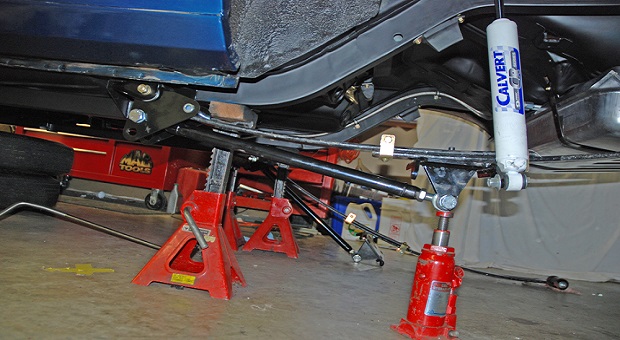
Something many grizzled old racers will remember is the saying “hooks hard – goes straight”. It was used pretty much everywhere, and it was particularly common when you’d see a car advertised for sale. It wasn’t just a passing statement, either. There were plenty of squirrelly cars out there, and the truth is, there still are! Getting a car to hook properly isn’t quite as easy as it looks, even with back to basics leaf springs out back.
Plenty of early passenger cars used leaf springs on the rear. That makes bolting on rear traction devices pretty simple. Unfortunately, simple doesn’t necessarily mean adjustable. And in some cases, simple doesn’t always work that well either – especially if your car has serious heat under the hood. Additionally, some of the traction bar information gleamed from years gone by has little or nothing to do with the way cars are set up today.
We took the notion of modern leaf spring traction to the folks at Classic Industries and asked for their thoughts. The response was straight to the point: “Use the entire Cal-Tracs system we stock”. That system includes the special Cal-Tracs traction bars, unique split mono-leaf springs, dedicated shock absorbers designed specifically for the Cal-Tracs and several tuning bits.
What’s with “split” leaf springs? According to the Classic Industries team, split mono-leaf springs are considerably lighter than factory leaf springs (especially multi-leaf jobs). This reduces unsprung weight, and at the same time, the new spring package allows you to select the ride height you need for your car. Additionally, the split mono-leafs are designed to work with the Cal-Trac bars. Classic Industries points out that many different leaf spring configurations have been tested over the years. Included are stock mono leaf, multi-leaf, multi-leaf with a single added thick leaf, multi-leaf with very heavy leafs, biased multi-leafs (like an old Chrysler SS spring), parabolic mono-leafs and finally, split mono leafs. Typically, cars have performed the best with the split mono leaf springs. A big reason for this is the fact that the front segment of the spring can be manufactured super-stiff. Coupled with the way the Cal-Tracs work, it allows the suspension to mimic a four link.
Classic Industries can supply you with split mono leaf springs for a wide range of cars in an equally wide range of ride heights – stock, +1 and -1 are the basics (special orders are possible). In addition, you can also get the springs tailor-made with regard to spring rate (the rate ranges from approximately 200 to 225 pounds).
Now, if you’re wondering, these springs are at home on the street. That’s one of the basic tenants of the Cal Trac system. According to Classic Industries, a lot of their customers with leaf spring vehicles still use them as double duty machines (street and strip). If those cars were converted to something like a ladder bar or a four-link, the suspension hardware required to get the job done (panhard bar, anti-roll bar, watts links components and so on), tend to limit their usefulness on the street side of the equation. The Cal Trac setup doesn’t have those issues.
Now, those split mono leaf springs we’re talking about look quite a bit different than the setups you’re likely used to. In the accompanying photos, we’ll give you a detailed look at them:










Awesome article, I always ran ladder bars on street/strip cars that had enough power a set of “traction bars” on leaf springs couldn’t handle. Can’t wait to read more about the Cal Trac system. Wonder if there is a system for 77 Vega wagon lol.